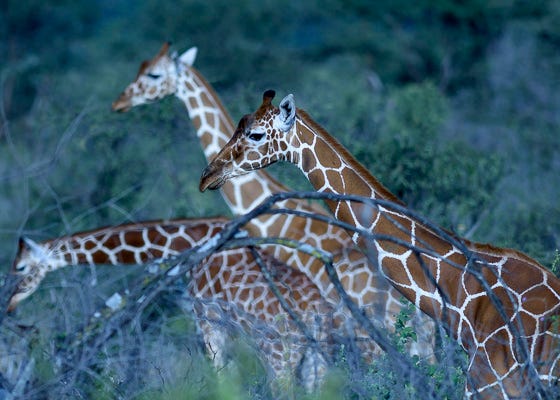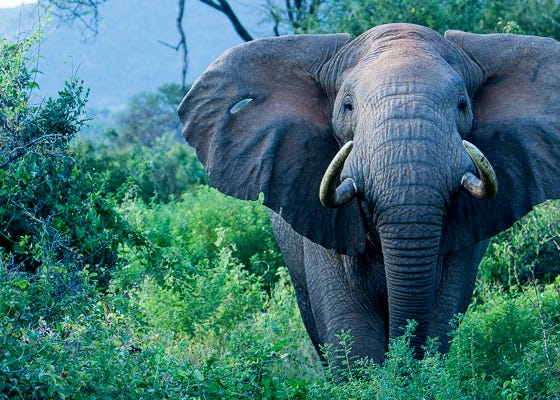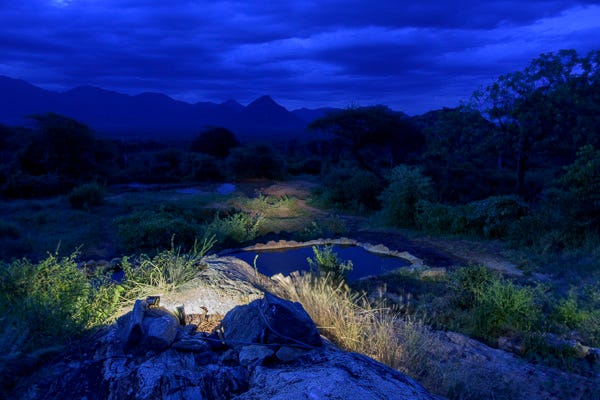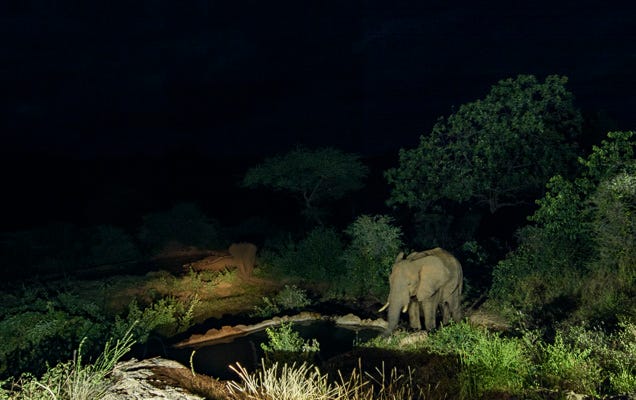Last weekend, I thought I was spent, kaput, wrung out, done. I had been helping a friend’s son build a math garden for his Eagle Scout project — a garden based on math principles, like this garden at the Salvador Dali Museum in Florida, said to be inspired by Dali’s love of “the Apollonian and the Dionysian” — but just as I was leaving, I saw a fox.
She had long black stockings, this fox, and she was creeping along the edge of the nearby baseball field. We looked each other in the eye.
I had my short lens on my camera — I was trying for portrait photos of the kids as they built the garden — and a cup of coffee in my hand. I had a couple of choices: I could take a few steps towards the fox and, if I was lucky, I’d get a blurry picture of the fox with my iPhone. Or I could break eye contact, look away, change lenses to my long lens — something I did so frequently on safari it now only takes me a second or two, even though every time I think to myself that you’re probably not supposed to handle lenses or the camera body in this way but fuck it — and then find her again.
I changed lenses. I looked up. The fox was nowhere in sight.
I walked over the the fence line. Nothing, not a trace. I climbed the stairs up to the ridge where the grass met the fence, though a moment ago, I would have thought that if I didn’t get into a prone position with a drink with an umbrella in it within fifteen minutes, I might die.
The landscape was barren of foxes. And yet, she must be near.
There were some bleacher seats next to the fence. I sat down to wait.
***
Waiting, I find, is what I do a lot of as a wildlife photographer.
I have a lot of time to think while I wait. Usually, I’m thinking, “maybe I’m not a very good wildlife photographer.”
You’d think it would be a meditative time, but I’ve found it rarely is. Sometimes I think about that. “Why the fuck aren’t I meditating right now? It’s beautiful out here. Look at that bird, the way it just landed. I probably should have captured that. I could be meditating. Meditate, dammit!”
This is a uniquely ineffective way to induce meditation, in my personal experience.
The problem with waiting for wildlife, particularly wildlife with which you’re not familiar, is that you have no idea what’s going to happen next. Crouching along the fence line seems like a foxy thing to do, but do foxes tend to go out in the middle of the day? Probably not?
So could this be a rabid fox (in which case, sitting here is a very bad plan indeed). Could it be a denning fox with cubs, in which case she’ll likely be back soon? Could it be a male fox marking his territory or looking for females, in which case this might be the first time he’s ever walked this way before, and he might never walk this way again?
So you wait.
***
The most memorable night of waiting I ever spent was in northern Kenya, in the Mathews Range, the last place I ever went on safari.
The Mathews Range of mountains raises the heart of Kenya to the clouds, and land in this range is so arid, the local tribes are known for their singing wells — wells that they dig each day into the sand. Singing, the men form chains, passing buckets of water up to the cattle and other domestic animals. The cattle are said to know their own family’s songs; when they hear it, they split off from the larger herd to join their people at the well.
There are limited recordings of this tradition; the local tribes are wary of cameras or digital recorders of all kinds.
Michael, my then-husband, and I were not able to witness the singing wells tradition because, right before we got there, it poured. It absolutely rained buckets. Can you imagine? This near-desert, inundated with water.
It exploded, of course. It rioted. Instead of driving through hard, dusty landscapes, we were hacking our way through jungles of green, listening to the trumpeting of elephants echo off the mountain walls.
All of which meant that the hotel’s famous wildlife watering hole — placed carefully under tiered layers of outcroppings and promenades so that you could sit in the hotel’s tent-lounge or, better yet, in the small human-pool and watch the wildlife enjoying their own pool of sorts down below — all of it was now made somewhat redundant. Water was everywhere. The great herds of baboons and warthogs and giraffe and elephants and a veritable Noah’s ark of other creatures that normally came to drink now might wander through and take a sip but with no real urgency or in no real numbers.
I didn’t realize that at first, because I’m stubborn and I see things the way I want to see them and in this case I had paid for a watering hole and here was a watering hole and I failed to consider the environmental changes afoot that might affect the watering hole.
The first night, I set up my camera in a hide. It was meant to go off whenever it sensed movement, but ether there were no animals at the watering hole, or they were too far away. Worse than that though — instead of animals, I did capture one of the local employees who walked down to the pool first thing in the morning to let her young son play there before the guests got up. I’ve already mentioned that many Kenyans don’t like to have their picture taken, and I still feel guilty about this picture taken without consent. Obviously, I couldn’t use that method again — I would have to figure out a way to be aware of the pictures I took.
The next night, it rained.
The third night, I set up my camera on a tripod on a rock outcropping and used a remote control to try to take pictures. The askari of the camp — a night guard — sat with me. He had limited English, and I had none of his several languages.
We turned out the lights so that the crickets — a plague of them that eventually became international news — would bother us less. Sometimes one would hit me randomly, and I would jump, and the askari might chuckle a little. There was just the glow from the pool, and below that, some lights directed onto the watering hole.
We settled in.
Occasionally something would come to the watering hole. “An elephant,” the askari would say. “A warthog.”
I captured a few elephants, but badly. They were like ghosts — I held the shutter open too long. Because I was doing it by remote control, I had no way to check and adjust.
I had a sense, even then, that things were not going well. Already I knew that the watering hole was not attracting the crowds it was famed for. But also — were my settings right? How to adjust for the light from the pool, at night?
Aside from my occasional twitch, the askari and I continued to sit. We listened to each other breathing.
Occasionally, a Kenyan Wildlife ranger might slip through the camp, fully armed and as silent and deadly as a genet. (1)
To wait is to accept that the animals were probably a lot better right before you arrived. I thought about how arid the place usually was, and how lush it was now, and how that might affect the animals coming to the watering hole. Sitting in the dark, waiting, I accepted that I would not see many more animals tonight.
Some time passed. More crickets hit my calves, my back.
I thought — as I often do — about the photographer Sooyong Park who lived in a concrete bunker for six to seven months out of the year to capture Siberian Tigers. He read labels on canned goods for company. He could not stand in his bunker.
At first I observe and ponder things outside myself: mountains, trees, grass, wind, snow, ocean, and so on. But before long that becomes tedious. Then I come back to myself and explore my inner life. Who am I? But exploring myself soon becomes tedious too. Humans can’t live alone—we need to live together. When we don’t have any relationships, it’s possible to truly see the importance of relationships. Being in the bunker granted me this understanding.
If I left now, the animals might come after I left. They might juggle. The baboon might give a speech. The elephants might hold a dance.
I accepted that, but I sat a little longer. I was starting to enjoy myself. I sensed the askari was too. “Another elephant,” he would say, occasionally, under his breath. It was unusual for a guest to stay up late like this to watch the watering hole, unusual to rely on the night guard for wildlife help.
I’ve been listening to a podcast lately — as in now, lately, not safari-lately — called “Between the Covers.” It’s a podcast for writers, and so far I particularly like their Crafting with Ursula series. In one of the series, Isaac Yuen, a nature writer, and the host of the series, David Naimon, discuss the tension between feeling alien and feeling at home in nature.
“Eco” — as in ecology, as in economics — is Greek for “home.” To love the earth, to love nature is to feel at home. At the same time, to watch animals is to watch an alien intelligence make sense of the world, but make a different sense than your sense. An animal might make a differently colored sense of the world. An animal might make a differently noised sense. Who knows if the fox would come again. Who knows how the animals would behave tonight, or any other night. They had their own lives to lead, their own rain, their own relationships.
The constellations turned. They were new ones to me, no doubt, but since I’m terrible about identifying the ones in North America, I was sure I couldn’t identify these. They were thrown glitter. I thought I might be able to see the Milky Way, which looked like pursed lips or a seed pod or something zipped that might come unzipped.
And then, finally, I was tired. I asked the askari to help me down the rock to collect my equipment. He pointed out the stars, I tried to take a picture. The picture was unsuccessful. He high-fived me anyway.
We had waited together — just the crickets, a few ghost elephants, and us. The night was more than half over, and we had been human, together.
(1) For more on life as a wildlife ranger, check out Life on the Frontline, a 2019 report by the World Wildlife Fund, or The Thin Green Line, a non-profit directing money to wildlife rangers and the important work they do.
My friend Johnny took a tour of the trees in his New York neighborhood through the company Arborpolitan, after which my phone popped with pics of trees and their IDs like an azalea bush in springtime. I don’t know nearly enough about trees — notice I used a flowering bush metaphor instead of a tree metaphor — and had never even considered doing something like this, but now that I know this exists, I might seek out something similar, and thought you might be interested too.
A librarian friend pointed out that, if you travel to Iceland, their especially short, furry horses (that I love!) will now write your out-of-office message for you. You pick one of three adorable horses, fill in a little info (which I’m sure will be used for marketing purposes), and the horse will walk across a horse-sized keyboard, thus producing a string of nonsense that goes into an out-of-office email proving how completely out-of-touch you are while in Iceland. (So out of touch, horses are writing your emails!) OK, it’s a gimmick, but it’s a fun gimmick.
That’s all my news for the week — please do share your nature news here, and have a wanderful week.












A lovely piece on silence and what to do with it!
Given your last WanderFinder, when you were waiting for the fox, the theme to Jaws went through my head. Be careful out there.